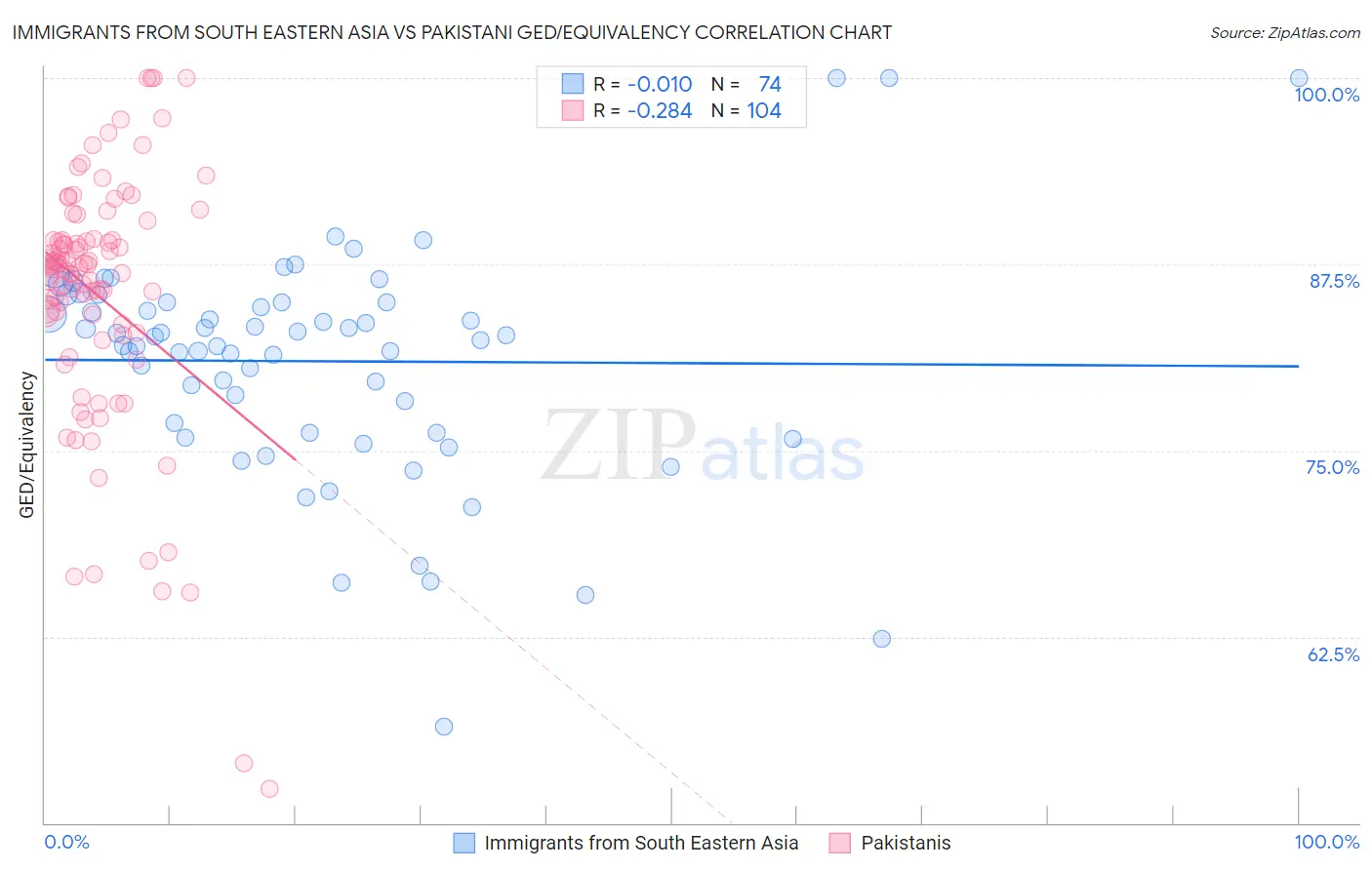Immigrants from South Eastern Asia vs Pakistani GED/Equivalency
COMPARE
Immigrants from South Eastern Asia
Pakistani
GED/Equivalency
GED/Equivalency Comparison
Immigrants from South Eastern Asia
Pakistanis
84.1%
GED/EQUIVALENCY
2.5/ 100
METRIC RATING
240th/ 347
METRIC RANK
86.4%
GED/EQUIVALENCY
80.4/ 100
METRIC RATING
145th/ 347
METRIC RANK
Immigrants from South Eastern Asia vs Pakistani GED/Equivalency Correlation Chart
The statistical analysis conducted on geographies consisting of 512,708,901 people shows no correlation between the proportion of Immigrants from South Eastern Asia and percentage of population with at least ged/equivalency education in the United States with a correlation coefficient (R) of -0.010 and weighted average of 84.1%. Similarly, the statistical analysis conducted on geographies consisting of 335,356,802 people shows a weak negative correlation between the proportion of Pakistanis and percentage of population with at least ged/equivalency education in the United States with a correlation coefficient (R) of -0.284 and weighted average of 86.4%, a difference of 2.7%.

GED/Equivalency Correlation Summary
| Measurement | Immigrants from South Eastern Asia | Pakistani |
| Minimum | 56.5% | 52.3% |
| Maximum | 100.0% | 100.0% |
| Range | 43.5% | 47.7% |
| Mean | 81.0% | 85.4% |
| Median | 82.5% | 87.3% |
| Interquartile 25% (IQ1) | 76.2% | 83.2% |
| Interquartile 75% (IQ3) | 84.9% | 89.1% |
| Interquartile Range (IQR) | 8.8% | 5.9% |
| Standard Deviation (Sample) | 7.6% | 8.6% |
| Standard Deviation (Population) | 7.6% | 8.6% |
Similar Demographics by GED/Equivalency
Demographics Similar to Immigrants from South Eastern Asia by GED/Equivalency
In terms of ged/equivalency, the demographic groups most similar to Immigrants from South Eastern Asia are Immigrants from Bahamas (84.2%, a difference of 0.020%), Immigrants from Peru (84.2%, a difference of 0.040%), Subsaharan African (84.2%, a difference of 0.10%), Senegalese (84.0%, a difference of 0.14%), and Sri Lankan (84.0%, a difference of 0.16%).
| Demographics | Rating | Rank | GED/Equivalency |
| Immigrants | Panama | 4.1 /100 | #233 | Tragic 84.4% |
| Immigrants | Nigeria | 3.6 /100 | #234 | Tragic 84.3% |
| Ghanaians | 3.5 /100 | #235 | Tragic 84.3% |
| Immigrants | Eritrea | 3.5 /100 | #236 | Tragic 84.3% |
| Sub-Saharan Africans | 3.0 /100 | #237 | Tragic 84.2% |
| Immigrants | Peru | 2.7 /100 | #238 | Tragic 84.2% |
| Immigrants | Bahamas | 2.6 /100 | #239 | Tragic 84.2% |
| Immigrants | South Eastern Asia | 2.5 /100 | #240 | Tragic 84.1% |
| Senegalese | 1.9 /100 | #241 | Tragic 84.0% |
| Sri Lankans | 1.9 /100 | #242 | Tragic 84.0% |
| Cherokee | 1.3 /100 | #243 | Tragic 83.9% |
| Immigrants | Ghana | 1.3 /100 | #244 | Tragic 83.9% |
| Immigrants | Senegal | 1.2 /100 | #245 | Tragic 83.8% |
| Chickasaw | 1.2 /100 | #246 | Tragic 83.8% |
| Immigrants | Western Africa | 1.1 /100 | #247 | Tragic 83.8% |
Demographics Similar to Pakistanis by GED/Equivalency
In terms of ged/equivalency, the demographic groups most similar to Pakistanis are Basque (86.4%, a difference of 0.030%), Immigrants from Northern Africa (86.3%, a difference of 0.030%), Immigrants from Poland (86.3%, a difference of 0.030%), Menominee (86.3%, a difference of 0.040%), and Immigrants from Western Asia (86.3%, a difference of 0.050%).
| Demographics | Rating | Rank | GED/Equivalency |
| Immigrants | Argentina | 86.5 /100 | #138 | Excellent 86.6% |
| Immigrants | Malaysia | 85.0 /100 | #139 | Excellent 86.5% |
| Paraguayans | 84.1 /100 | #140 | Excellent 86.5% |
| Laotians | 83.2 /100 | #141 | Excellent 86.5% |
| Immigrants | Indonesia | 82.4 /100 | #142 | Excellent 86.4% |
| Immigrants | Pakistan | 82.4 /100 | #143 | Excellent 86.4% |
| Bolivians | 82.1 /100 | #144 | Excellent 86.4% |
| Pakistanis | 80.4 /100 | #145 | Excellent 86.4% |
| Basques | 79.5 /100 | #146 | Good 86.4% |
| Immigrants | Northern Africa | 79.3 /100 | #147 | Good 86.3% |
| Immigrants | Poland | 79.3 /100 | #148 | Good 86.3% |
| Menominee | 79.3 /100 | #149 | Good 86.3% |
| Immigrants | Western Asia | 78.8 /100 | #150 | Good 86.3% |
| Immigrants | Bosnia and Herzegovina | 77.9 /100 | #151 | Good 86.3% |
| Brazilians | 77.2 /100 | #152 | Good 86.3% |